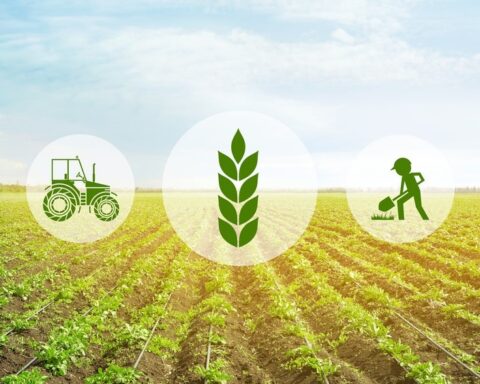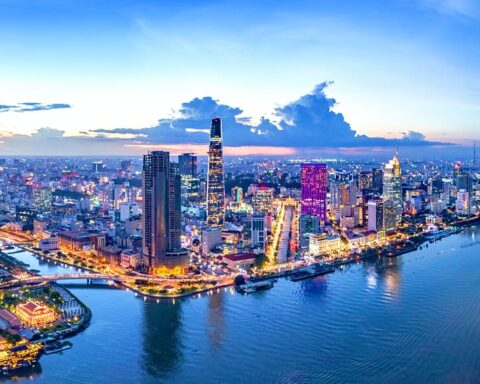The tattered bag must have been floating around for an eternity, since it was full of moss and seaweed.
This incident spoiled a little bit my Christmas vacation – the first one I had taken in Vietnam since leaving the country many years ago. When I first arrived in Vietnam, I was absolutely stunned by the pristine beauty of the beaches and sparkling waters before me. Hence it was so jarring that my return was marred by the country’s mounting plastic problem.
Since recently returning to live in Vietnam, I have been ruminating on the changes I now see: the country has gone from not having enough to feed its own citizens to being an export powerhouse of rice, coffee, fish, and tourism. The economy is among the fastest growing in the world and poverty has nearly been eradicated.
However, with this new wealth has come the complication of increased production, consumption, and disposal of plastics. According to a recent World Bank survey, plastic items accounted for 94 percent of all solid waste collected at 38 riverbank and coastal sites around the country, the majority of which were single-use plastics. The plastic consumption rate per capita in Vietnam rose ten times between 1990 and 2019. On average, a Vietnamese person now consumes 41.3 kilograms of plastic in a year. This is the equivalent of 7,600 plastic grocery bags. For every single person. Every single year.
To be fair, this figure is less than half of the biggest plastic consumers in the world. But what floors me is the amount of this plastic that ends up in the ocean. A widely cited global study in 2015 estimated that up to 730,000 tons of plastic made on land in Vietnam became marine litter.
Unmitigated plastic litter continues to make its way into Vietnam’s vast marine environment, threatening marine biodiversity and contaminating marine life – all of which have economic consequences . Vietnam’s fish harvest will become less appetizing when contaminated with micro-plastics while its beaches will draw in fewer tourists if they have to swim and sunbathe next to piles of plastic trash, or, in my case, thrash in fear as a nylon bag envelops their leg while swimming!
Urgent action required to improve Vietnam’s waste management
Vietnam’s waste treatment infrastructure is struggling with the ever-growing demand for services. Waste collection covers just 92 percent of the urban population and only two-thirds of the rural population. Moreover, collected waste often ends up being dumped in inadequate landfills, which leak rubbish into watercourses.
Given this low starting point, investing in a modernized waste management system would go a long way toward stopping the plastic leakage. But a comprehensive system upgrade will cost billions of dollars, necessitating partnerships between the public and private sector to maximize the resources.
International experience has shown that the private sector has a lot to offer in terms of finance and innovation. However, the role of the Government of Vietnam in creating the enabling environment for an improved waste management sector is crucial. One investor told me that reviewing existing investment policies and laws is like entering a labyrinth – a world lacking specificity and full of hidden surprises. This regulatory maze must be addressed if affordable solid waste solutions are to be found.
The future is brighter in a circular economy
Still, improving waste management alone won’t solve the plastic pollution problem. A plastic pollution-free future requires a transition from the current, linear ‘take-make-dispose’ model to a circular ‘reduce-reuse-recycle’ economy.
In a circular economy, very little of plastic will become waste or pollution.
That sounds wonderful. But what does it take to make it a reality?
Well, it requires a lot of breakthroughs in science and business models. It requires a lot of behavioral changes. It requires effective, coordinated, and concrete public policies to push for a transition that otherwise would not happen.
In short, it requires a lot. But we can do it – one step at a time. The World Bank offers toolkits, ideas and financing that combine both international best practices and in-depth understanding of local contexts. Our upcoming study on plastic circularity market in Vietnam identifies high-impact, scalable private solutions as well as actionable policy actions for such a market to pan out.
For example, in Vietnam 2.62 million tons of plastics are disposed of every year, meaning 75 percent of the total material value of these plastics are lost. This presents an opportunity for the recycling sector. With the right framework in place, it is possible to bring this market to life in 5 to 10 years from now.
If you are skeptical, just look at the booming solar and wind industry in Vietnam. This market was virtually non-existent less than five years ago.
The State and the private sector play a big role in turning the tide of plastic pollution. But individuals—like you and me—have the power to speed up the process by reducing and reusing plastic items whenever we can. The concept of “accumulation effect” states that no action is too small if it is taken by so many.
My family loves Vietnam’s oceans. We all do. The oceans are not simply a place for recreation but an important, healthy source of food and livelihoods for billions of people on Earth. And we shouldn’t forget the huge chunk of oxygen we breathe comes from the deep seas.
Keeping the oceans healthy benefits us all.






